
Several ago, I wrote about the confusing world of dehumidifier capacity. That quantity tells you how much water a dehumidifier will produce in a given amount of time. Here in the U.S., we use pints per day, but any volume per unit time will work. The efficiency of a room dehumidifier is another important quantity, although it gets far less attention. Dehumidifier efficiency is usually given as the amount of water produced per unit of energy used. And because we’re not completely backward with regard to units here in the U.S., we use liters per kilowatt-hour (L/kWh) for that one.
Measuring dehumidifier performance
When you buy a dehumidifier, whether it’s a standalone room dehumidifier or a full-blown whole-house ducted dehumidifier, you can get the specifications for it. I’ve got a room dehumidifier in my basement that came with the house I bought two years ago. It’s a GE model ADEL50LRL2 made in 2014. The 50 indicates a nominal capacity rating of 50 pints per day (using the old standard).
I looked up the efficiency in a spreadsheet of historical data for older dehumidifiers on the U.S. Environmental Protection Agency website. The rated capacity is 51.84 pints per day, and the rated efficiency is 1.85 L/kWh. But how does it really perform? I’m going to talk mostly about the efficiency, but I did take a quick look at the capacity. My data show that it really produces about 38 pints per day, but that’s with the dehumidifier running continuously.
Over a two month period this summer, I collected data on energy use and water produced by this little dehumidifier. I used the same bucket you saw in the photo of my hot water measurements for the volume of water produced. To measure energy, I used an Emporia Smart Plug, one of my new favorite building science tools. I tracked my data in an Excel spreadsheet.
The official rated efficiency, called energy factor for older dehumidifiers like this one, is 1.85 L/kWh. I did measure 1.90 L/kWh one time, but that was an anomaly. I did the experiment in two separate runs. For three weeks, I measured the performance with the dehumidifier running nearly continuously. Then I measured it with the dehumidifier running intermittently. Here are the results:
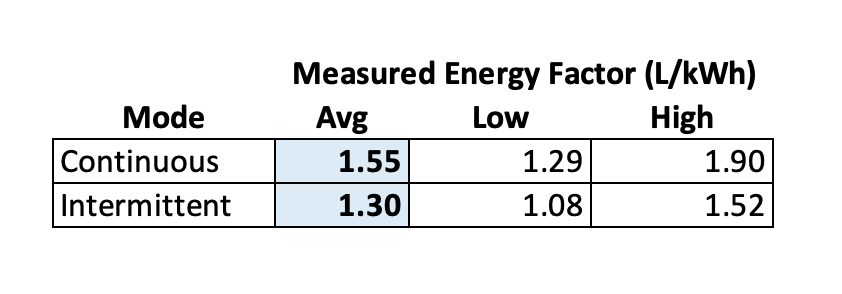
As you can see, the averages are significantly below the rated energy factor of 1.85 L/kWh. When running continuously, it’s 16% lower. When running intermittently, it’s 30% lower. The intermittent number is closer to what you’ll probably get in real-world conditions.
The effect of runtime
Let’s look at three graphs of data from my smart plug. The first one shows the dehumidifier running continuously. When running, it uses about 485 watts of power. In one hour, it would use just less than 0.5 kilowatt-hour of energy. If it ran continuously all day, it would use close to 12 kWh of energy and cost me about $1.50.
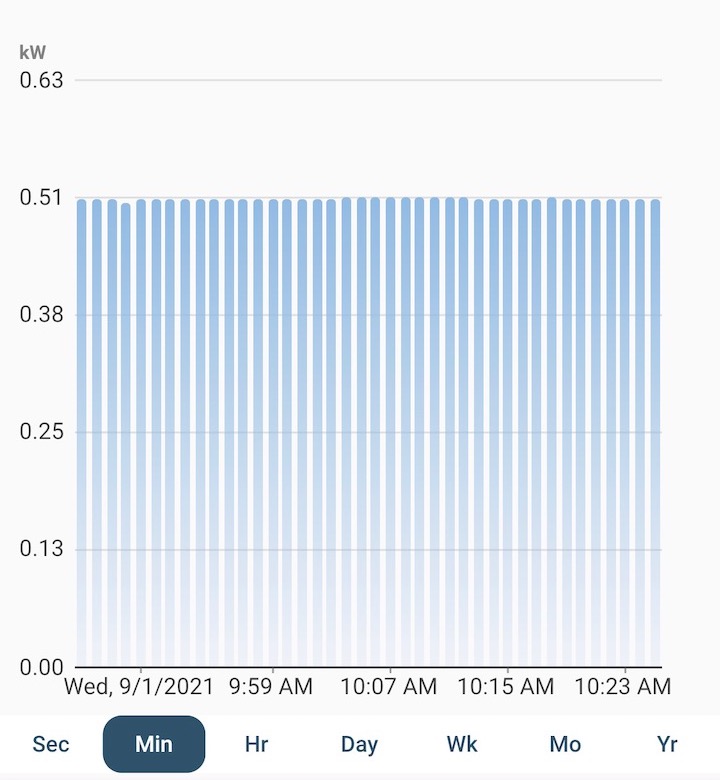
But if you have a room dehumidifier running continuously, you probably ought to look into ways to reduce the humidity through air sealing or crawl space encapsulation. And get a more efficient dehumidifier. In my basement, the dehumidifier cycles on and off when I set it for an appropriate relative humidity. The graph below shows a medium rate of cycling. It comes on for 8 to 10 minutes, then goes off for 4 or 5 minutes.
That hurts efficiency because when the compressor goes off, the coil warms up and loses its ability to dehumidify. When the dehumidifier comes back on, it takes some time before the coil gets to its lowest temperature again.
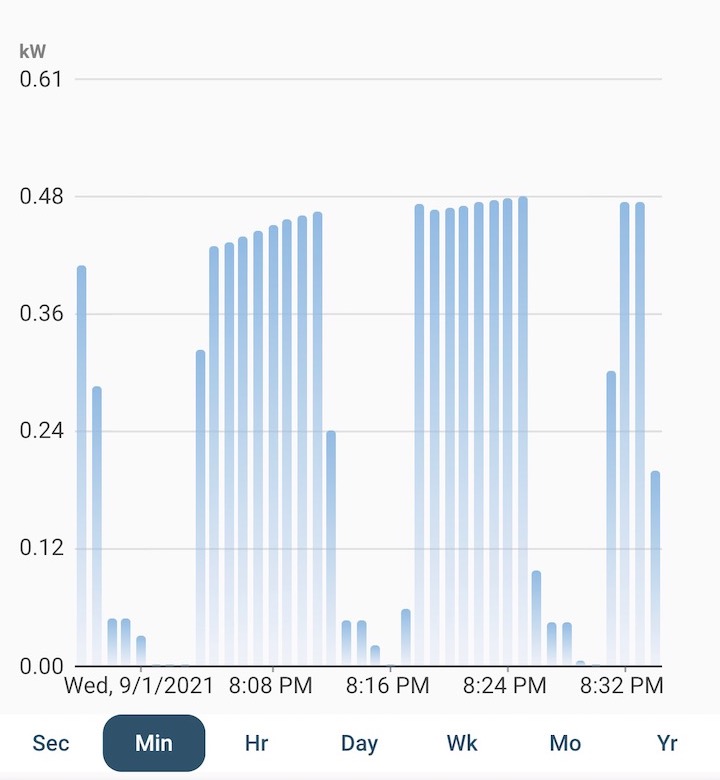
Then there are times when the cycles are short. In the graph below, the dehumidifier gets 2 minutes of runtime at full power with a bit of time ramping up and another bit of time ramping down. Then off for 5 minutes before starting up and having to cool the coil all over again. Not good for the efficiency of a room dehumidifier!
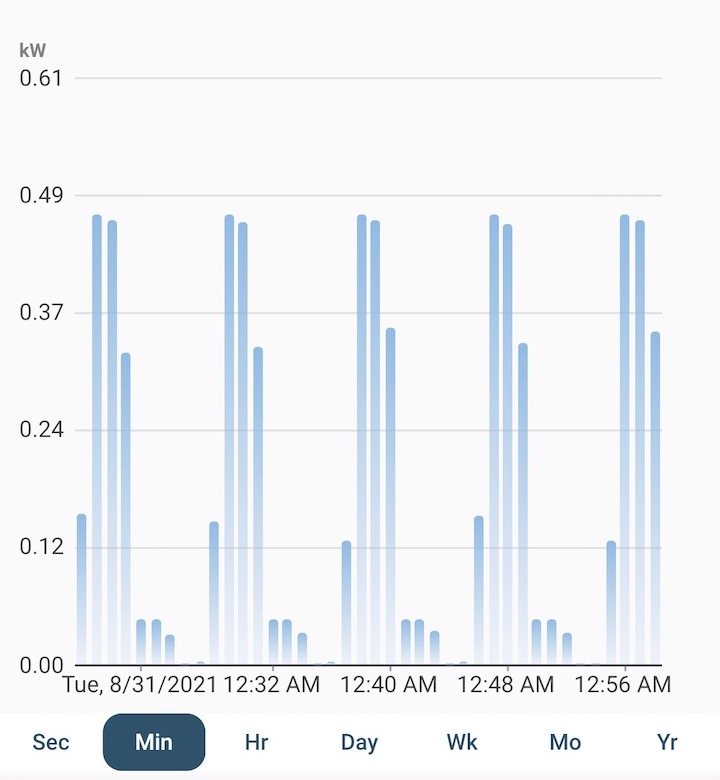
The effect of settings and weather
There are two reasons for short cycling. The first is how you set the dehumidifier. When I first began this little experiment, I set the dehumidifier to 60% relative humidity. That’s when it was running continuously. What was the actual humidity level in the basement? In the low 50s. So I changed the setting to 65% and then 70%. I now leave it at 70% and that keeps my basement relative humidity at about 57%.
The lesson here: Don’t trust the reading on your dehumidifier! It can be very far off. I don’t need to keep the basement at 50% relative humidity. That’s a waste of energy. Plus, I work down there and currently don’t have air conditioning while the basement renovation is on hold until I finish the book. Running the dehumidifier more means lower humidity but higher temperature. (A dehumidifier mostly converts sensible heat to latent heat. The electricity used also gets converted to sensible heat.)
The second reason for the variation in cycle time is weather. On a hot sunny day, the dehumidifier runs less. I don’t have AC in the basement, but I do get some cool, dry air from the main floor coming down the stairs. When it’s hot outdoors, the AC upstairs runs and dehumidifies more so the basement dehumidifier runs less. At night or on cooler days, the AC runs less, the basement humidity is higher, and the dehumidifier runs more. Those are the best times for a dehumidifier to run, too, because converting that latent heat (humidity) to sensible heat (higher temperature) can make the air conditioner run more.
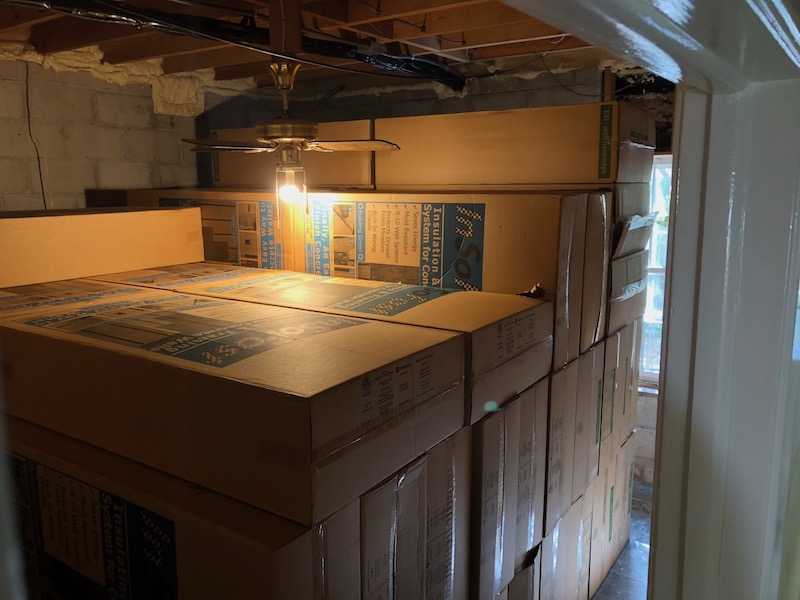
My basement is too humid now for a couple of reasons. As mentioned, I don’t have air conditioning there. Also, even though I have an encapsulated crawlspace, overall the basement is still too leaky. Once my book is done, I’ll gut the whole basement and then install the InSoFast insulation panels. I’ve already bought the panels, and have air-sealed the heck out of the basement. Because, you know, a house doesn’t need to breathe.
But back to the subject of dehumidifiers. The efficiency of my room dehumidifier is about 1.3 liters of water for each kilowatt-hour of electricity used. How efficient are the best dehumidifiers? The Santa Fe Ultra line of dehumidifiers are rated at up to 3.6 liters per kilowatt-hour. I’ll be testing one of those in the future.
_________________________________________________________________________
Allison Bailes of Atlanta, Georgia, is a speaker, writer, building science consultant, and the founder of Energy Vanguard. He has a PhD in physics and writes the Energy Vanguard Blog. He is also writing a book on building science. You can follow him on Twitter at @EnergyVanguard.
Weekly Newsletter
Get building science and energy efficiency advice, plus special offers, in your inbox.















5 Comments
The data suggests that a humidistat with more hysteresis would probably pay for itself in increased efficiency. Would be interesting to test this.
Would the grooved rear side of the InSoFast panels allow for water vapor to migrate upward and into the basement? Or would this work downward like liquid water?
Also, what are you planning on for a floor assembly? I have very slight intermittent ground water penetration at the floor-wall joint despite the installed ground water sump, and would think a dimple underpayment might be appropriate. What would work with the InSoFast?
Will, I'm planning on getting the panels sealed tight to prevent air, water vapor, and any soil gases that might be behind the panels from getting into the living space. I haven't figured out all the details of the floor assembly yet, but I'll put plywood on top of the panels and the finished floor on top of that.
Check the InSoFast website (https://www.insofast.com/) for more details. They're also good at responding to questions.
I, too recommend a separate humidity gauge to help set a basement relative humidity (RH) correctly. The relative humidity at which basements and their stored contents start to grow mold varies. I keep the RH in our basement around 57%, but that RH might be too high for some cold climate basements.
Some factors:
1) Whether the basement slab is insulated or not, and the temperature of the basement slab (slab temp is close to the deep ground temp of 50F here in Madison WI. Putting moist air from the Gulf of Mexico into a basement with cold walls and slab is a recipe for condensation).
2)How dry the basement is, both from liquid water leaks and for water vapor from walls. (Insulated walls transmit less moisture according to research from Minnesota.)
3) Whether air circulation into corners and slab edges is blocked by stored items. And whether stored items are sitting directly on the slab. Worst case is cardboard, leather, paper etc. stored directly on a slab in an exterior corner. If the RH in that area hits 70%, you have 24 hours to dry things out before mold grows.
FFI:
http://www.homeenergy.org/show/article/id/777
https://www.osti.gov/servlets/purl/1172130
And, an attachment to this .pdf I wrote several years ago, trying to give a short version of dehumidifier advice for a cold climate basement.
Log in or create an account to post a comment.
Sign up Log in